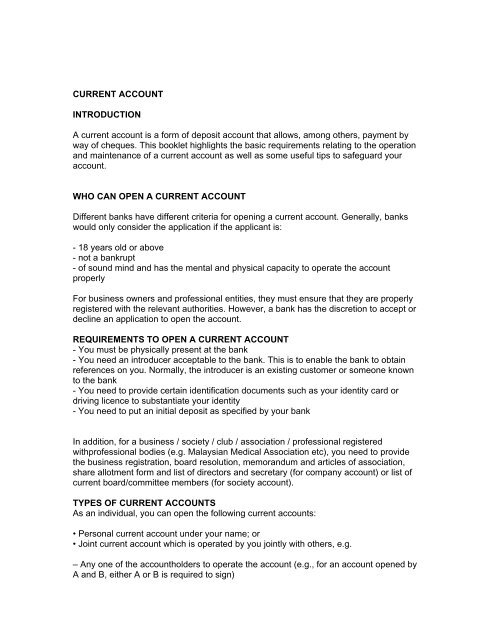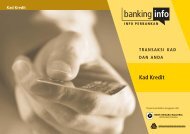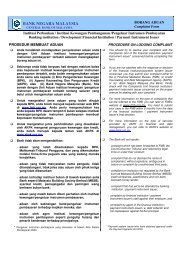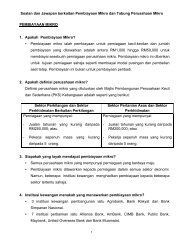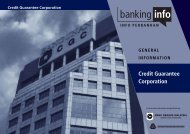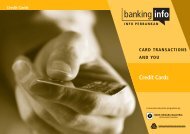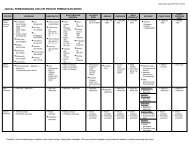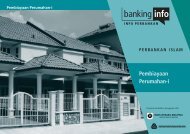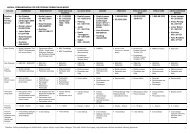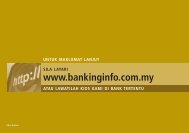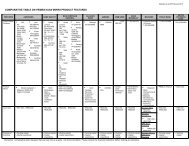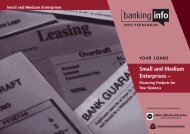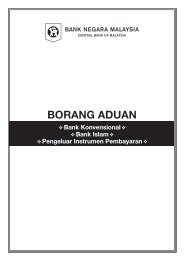CURRENT ACCOUNT - Banking Info
CURRENT ACCOUNT - Banking Info
CURRENT ACCOUNT - Banking Info
Create successful ePaper yourself
Turn your PDF publications into a flip-book with our unique Google optimized e-Paper software.
<strong>CURRENT</strong> <strong>ACCOUNT</strong><br />
INTRODUCTION<br />
A current account is a form of deposit account that allows, among others, payment by<br />
way of cheques. This booklet highlights the basic requirements relating to the operation<br />
and maintenance of a current account as well as some useful tips to safeguard your<br />
account.<br />
WHO CAN OPEN A <strong>CURRENT</strong> <strong>ACCOUNT</strong><br />
Different banks have different criteria for opening a current account. Generally, banks<br />
would only consider the application if the applicant is:<br />
- 18 years old or above<br />
- not a bankrupt<br />
- of sound mind and has the mental and physical capacity to operate the account<br />
properly<br />
For business owners and professional entities, they must ensure that they are properly<br />
registered with the relevant authorities. However, a bank has the discretion to accept or<br />
decline an application to open the account.<br />
REQUIREMENTS TO OPEN A <strong>CURRENT</strong> <strong>ACCOUNT</strong><br />
- You must be physically present at the bank<br />
- You need an introducer acceptable to the bank. This is to enable the bank to obtain<br />
references on you. Normally, the introducer is an existing customer or someone known<br />
to the bank<br />
- You need to provide certain identification documents such as your identity card or<br />
driving licence to substantiate your identity<br />
- You need to put an initial deposit as specified by your bank<br />
In addition, for a business / society / club / association / professional registered<br />
withprofessional bodies (e.g. Malaysian Medical Association etc), you need to provide<br />
the business registration, board resolution, memorandum and articles of association,<br />
share allotment form and list of directors and secretary (for company account) or list of<br />
current board/committee members (for society account).<br />
TYPES OF <strong>CURRENT</strong> <strong>ACCOUNT</strong>S<br />
As an individual, you can open the following current accounts:<br />
• Personal current account under your name; or<br />
• Joint current account which is operated by you jointly with others, e.g.<br />
– Any one of the accountholders to operate the account (e.g., for an account opened by<br />
A and B, either A or B is required to sign)
– All accountholders are needed to operate the account (e.g., for an account opened by<br />
A and B, both A and B are required to sign)<br />
For a business/company, the current account will be in the name of the business and it<br />
is operated by nominated signatory(ies).<br />
USAGE OF A <strong>CURRENT</strong> <strong>ACCOUNT</strong><br />
You can start using your current account once it is approved by your bank. Withdrawals<br />
from your account (subject to the available balance in the account) can be made either<br />
through cheques or ATM cards (issued to individual accountholders only) or by<br />
electronic means. There is no need to maintain the initial deposit amount i.e. the<br />
minimum amount required to open the account, once your account is in operation. You<br />
do not earn interest on the balance in your current account. However, for a hybrid<br />
account, that is, an account that combines the features of both a current and savings<br />
account, you may earn interest from the savings portion of the account.<br />
SIGNATORIES AND CHANGES OF SIGNATORIES<br />
When you open a current account, your bank will require your specimen signature. The<br />
bank will compare your signature on the cheque issued by you against this specimen<br />
signature. If the signature is different, the bank will refuse to pay the cheque and return<br />
the cheque on the ground that “signature differs”. For a joint current account, all the<br />
account-holders’ signatures must be provided together with specifi c instructions as to<br />
who can operate the joint account.<br />
For current accounts operated by a business/company, specimen signature(s) of<br />
person(s) authorized to sign cheques on behalf of the business/company and the extent<br />
of their authority, must be provided in the form of a mandate or resolution. Any changes<br />
to the signatories must be conveyed to the bank immediately in writing by the<br />
accountholder. In addition, an extract copy of the Board/Committee Resolution<br />
stipulating the change, effective date of change and signed in accordance with the<br />
conditions of the account must be given to the bank. The Resolution must be certified by<br />
the company secretary and signed by the quorum of directors as provided for in the<br />
memorandum & articles of association.<br />
ELEMENTS OF A CHEQUE (SEE DIAGRAM)<br />
It is important for you to know the elements of a cheque to ensure that the cheque is<br />
properly written since a duly completed and signed cheque acts as an authority to the<br />
drawee bank to withdraw from your account for payment to the payee.
1. Name of your bank which is also called the "drawee bank" or paying bank<br />
2. "Account Payee Only" crossing is a directive to the collecting bank to pay into the<br />
account of the payee<br />
3. Payee is the person to whom the cheque is to be made. Ensure that the name of<br />
the person is correctly spelt and written close to the words "pay to". Draw a line<br />
on the space after the payee's name to avoid alteration<br />
4. Date of the cheque. To be able to receive payment, the date must be the current<br />
date<br />
5. The person who holds and presents the cheque at the bank. It is advisable to<br />
cross out "or bearer" to avoid any stolen cheque from being paid out<br />
6. The payment amount written in words. The same value will be written in the box<br />
beside it. Ensure that the amount in words and fi gures are written close to the<br />
words "Ringgit Malaysia" and "RM" printed on the cheque. Do not leave any gap<br />
by drawing a line after them. Make sure that the amount in words and in fi gures<br />
tally, otherwise, the bank will return the cheque<br />
7. Your signature as the "drawer" of the cheque<br />
8. Serial number of the cheque. Each cheque has a different number for<br />
identification purposes<br />
9. The drawee bank's state and branch code<br />
10. Your current account number<br />
11. The drawee bank's internal code for current account product<br />
DO'S AND DON'TS WHEN USING CHEQUES<br />
DO’s<br />
• Write clearly and legibly and always use permanent ink pens such as a ball pen<br />
• Ensure no alteration/amendment/erasure on the face of the cheque as banks will<br />
reject such cheques
• Begin writing the amount in words close to the word "Ringgit" without leaving too<br />
much space in between the words written and always write the amount payable<br />
ending with the word "only". The amount in fi gures must be written close to the<br />
letters "RM" and should be written legibly<br />
• Make sure that no cheque is being removed from the cheque book without your<br />
knowledge and ensure that spoiled cheques are completely destroyed<br />
• Ensure that cheques are kept in a safe and locked place and never leave<br />
cheques whether signed or unsigned unattended<br />
• Undertake regular review of your stock of unused cheques and conduct regular<br />
reconciliation of cheques paid with your bank statement<br />
• Report immediately to your bank if there are cheques missing from your cheque<br />
book or discrepancies in your bank statement<br />
• Ensure your account has suffi cient funds before you issue a cheque. It is not the<br />
duty of your bank to call you when there are insuffi cient funds, although some<br />
banks may do so as part of their service to their customers<br />
• When sending cheques by mail using window envelope, ensure that the<br />
envelope is of good quality. This prevent cheques from being revealed when the<br />
envelope is held against any light<br />
DON’Ts<br />
• Write below the MICR (Magnetic Ink Character Recognition) fi eld of the cheque<br />
to allow smooth clearing of your cheque. The MICR fi eld is usually a 5/8 inch<br />
band at the bottom of the cheque<br />
• Sign any blank cheque or give any blank cheque as payment<br />
• Use laser printer, felt tip pen, erasable pen or pencil or other printing techniques<br />
which can be easily erased and written over, to write details on a cheque. If you<br />
are using a typewriter, you should not use correctable ribbons<br />
• Issue payments in foreign currency using RM denominated cheques<br />
• Fold, pin or staple written cheques. If the cheque is folded, the clarity of the<br />
wordings which fall across the "folded" lines may be affected. In addition, folding<br />
may break the MICR fi eld of the cheque, resulting in the cheque being rejected<br />
by the cheque processing system. Cheques should not be stapled to prevent<br />
accidental tearing<br />
REASONS FOR RETURNED CHEQUES<br />
Your bank will decline to pay a cheque issued by you due to the following reasons:<br />
- Insuffi cient funds in your account to clear the cheque<br />
- Missing signature(s)<br />
- Signature(s) differ from specimen signature(s) in the bank’s record<br />
- Post-dated<br />
- Stale cheque (cheque which is dated more than 6 months ago)<br />
- Amount in words and fi gures differ
- Alteration on the cheque (Note: Any alteration is not permitted)<br />
- Stop payment instruction has been issued<br />
- Account closed or "legally blocked" account<br />
Cheques which have been dishonoured will be returned to the accountholder. The issuer<br />
of the cheque will be charged a fee by his bank to recover part of the administrative cost<br />
incurred.<br />
STOP PAYMENT INSTRUCTION<br />
If your cheque has gone astray, it is possible to prevent payment of the cheque by giving<br />
a stop payment instruction to your bank. You may give the instruction by phone, but your<br />
bank would require you to confi rm your stop payment instruction in writing. In addition,<br />
you will be charged a fee for this service.<br />
However, if you issue a stop payment instruction due to insuffi cient funds in your<br />
account, you can be charged a penalty. If you repeatedly issue stop payment<br />
instructions when you have insuffi cient funds, your account may be closed by your<br />
bank. Such action is taken to ensure that cheques are accepted as a reliable mode of<br />
payment.<br />
KEEPING OF RECORDS<br />
Your bank will give you a statement of account which will allow you to check transactions<br />
that have taken place but the statement does not provide the most current balance. The<br />
statement will normally be for an earlier period and will not include any transaction that<br />
has taken place after the period referred to in the statement. You should therefore keep<br />
records of all deposits and withdrawals to calculate the current balance.<br />
DUTIES AND RESPONSIBILITIES OF AN <strong>ACCOUNT</strong>HOLDER<br />
Some of your duties and responsibilities as an accountholder are:<br />
• Keep your account numbers confi dential and keep your account statements in a safe<br />
and secure place<br />
• Safeguard and keep confi dential any PINs issued and linked to your account for ATM<br />
facilities, phonebanking and/or internet banking<br />
• Always destroy or shred cancelled cheques<br />
• <strong>Info</strong>rm the bank immediately of :<br />
– Any change of address<br />
– Any change of telephone number<br />
– Loss of any cheque / cheque book<br />
– Any discrepancy in your bank statement<br />
INACTIVE <strong>ACCOUNT</strong><br />
Where there has been no transaction (either a withdrawal or deposit) in the account for a<br />
period of seven years, the account will be classifi ed as unclaimed moneys. Under the<br />
Unclaimed Moneys Act (1965), such funds will be transferred to the Registrar of<br />
Unclaimed Moneys. Prior to the funds being transferred, banks will send notices
equesting the customer to reactivate or close the account. The owner of the unclaimed<br />
moneys may recover the moneys from the Registrar either in person or in writing.<br />
To do this, you will need to submit the following documents:<br />
- Application form for refund of unclaimed moneys (UMA-7). The form can be obtained<br />
from the Registrar‘s offi ce or downloaded from the website of Jabatan Akauntan Negara<br />
at http://www.anm.gov.my<br />
- Documents to support your claim over the unclaimed moneys, such as a bank<br />
statement or a letter from your bank<br />
- Copy of your identity card<br />
The address of the Registrar is as follows:<br />
Registrar of Unclaimed Moneys<br />
Jabatan Akauntan Negara<br />
Tingkat 42, Menara Maybank<br />
100, Jalan Tun Perak<br />
50050 Kuala Lumpur.<br />
CLOSURE OF A <strong>CURRENT</strong> <strong>ACCOUNT</strong><br />
An account can be closed under the following circumstances:<br />
- On accountholder's request – accountholder must provide a written request and return<br />
any unused cheque leaves for cancellation<br />
- On discretion of the bank – your bank may close your account if you regularly issue<br />
dishonoured cheques or if your account is inactive (dormant account). In such cases, the<br />
account will only be closed after suffi cient notices have been given in writing to the<br />
accountholder. A notifi cation letter will also be sent to the accountholder once the<br />
account is closed<br />
CHEQUE CLEARING<br />
When you deposit a cheque into your account, your bank which is the collecting bank<br />
will send it to specifi c clearing centres to be sorted and dispatched to the drawee bank<br />
for payment. The time taken for the money from the cheque to be credited into your<br />
account will depend on the number of days required to clear the cheque. The number of<br />
clearing days may be affected by public holidays which fall within the clearing period.<br />
Generally, cheques can be divided into 3 categories:
Generally, house cheques do not go through the clearing process. As such, you will<br />
receive your money the next day. However, the time taken may vary from bank to bank<br />
depending on the duration required to verify the particulars of payment. Local and<br />
outstation cheques however, need to go through the clearing process and the time<br />
required for your cheque to be cleared would depend on the location of the branches.<br />
Generally, local cheques would be cleared within 2-3 working days. The clearing period<br />
for outstation cheques may take 3-8 working days. However, you are advised to check<br />
with your bank as to the actual date the funds will be available.
FREQUENTLY ASKED QUESTIONS<br />
1. Where can I open a current account<br />
You can open a current account with any commercial bank or Islamic bank.<br />
2. Can I write a cheque with a future date<br />
The practice of issuing a post-dated cheque is not encouraged. This is to avoid any<br />
incidence of returned cheque due to insuffi cient funds and the resulting penalty<br />
charges.<br />
3. If a cheque is made payable to a company, e.g., ABC Sdn. Bhd or ‘bearer’, can<br />
the ‘bearer’ of the cheque encash it over the counter<br />
No. Generally banks will require you to deposit it into the account of ABC Sdn. Bhd. to<br />
reduce the incidence of fraud.<br />
4. Can a cheque be made payable to two parties i.e. A or B<br />
Yes. A cheque can be made payable to either A or B.<br />
5. Are "account payee only" cheques transferable<br />
No. When a cheque is crossed "not negotiable" or "account payee only", the cheque<br />
must be deposited into the account of the payee.<br />
6. How long is a cheque valid<br />
A cheque is normally valid for six months from the date of the cheque, after which, the<br />
cheque is considered a ‘stale cheque’. You are advised to present your cheque for<br />
payment within a reasonable time from its date of issue to avoid incidence of the cheque<br />
being dishonoured due to insuffi cient funds. You are also advised to get a replacement<br />
of the cheque once the validity period is over. However, there may be situations when<br />
the drawer of a cheque limits the cheque validity period to less than six months. For<br />
such cases, the validity period will be clearly printed on the face of the cheques.<br />
7. What should I do if I want to close my account<br />
Give a written instruction to the bank to close the account and return all unused cheque<br />
leaves to the bank for cancellation. In addition, if you have issued any cheque which has<br />
not been cleared, you should recall the cheque.<br />
8. Why would banks not accept my cheque which was altered, but counter-signed<br />
by me<br />
No alteration should be made on cheques as a safeguard against fraud. The bank<br />
reserves the right to dishonour and return cheques which in the bank’s opinion, bear any<br />
alteration (whether counter-signed by the drawer or otherwise). In addition, you (the<br />
issuer of the cheque) may be charged a fee by your bank to recover part of the<br />
administrative cost.
9. What is the difference between order cheques and bearer cheques<br />
Order cheques are cheques written to be paid to a specifi c person or entity (the payee)<br />
named in the cheque. Bearer cheques are cheques written to be paid to the person who<br />
holds the cheque (the bearer). An “order cheque” can be a “bearer cheque” if the words<br />
“or bearer” are not cancelled out. Sometimes, the cheque may be issued to pay “Cash".<br />
This is called a cash cheque. In general, issuing of cash cheques is not encouraged as<br />
they are exposed to risk of fraud. Some banks may charge a fee for encashment of third<br />
party cheques.<br />
10. What is a banker's cheque<br />
This is a cheque drawn on the bank. This means that payment is guaranteed by the<br />
bank. It is often used in situations where the payment needs to be secured, e.g.,<br />
payment for a large purchase item such as a car or house.<br />
11. Who is responsible for dishonouring my cheque<br />
The paying bank is responsible for determining whether payment should be made to<br />
you.<br />
12. What can I do if the cheque I banked in was returned to me for reason<br />
"account closed"<br />
You will have to recover the amount directly from the person who issued the cheque to<br />
you.<br />
13. What should I do if I found that some cheques are missing from my cheque<br />
book<br />
You should report this to your bank immediately and request for stop payment on these<br />
cheques.<br />
14. What is clearing day-hold<br />
Clearing day-hold refers to the time taken for funds from the cheques which have been<br />
cleared to be credited into the payee’s account. The time taken would depend on the<br />
type of cheque deposited, that is, whether the cheque is a house cheque, local cheque<br />
or outstation cheque.<br />
15. Why do banks charge customers for encashing account payee cheques<br />
To minimise the risk of loss from open cheques due to robbery, theft and fraud, banks<br />
have issued pre-printed account payee cheques. Notwithstanding this, some banks may<br />
allow the accountholder and the payee to encash the account payee cheques over the<br />
counter. However, to discourage such practice, a fee is usually levied over encashment<br />
of third party account payee cheques. The fee could either be charged to the payee or<br />
the issuer of the cheque depending on the practice of the bank concerned. Therefore, if<br />
cash is preferred mode of payment by the payee, you should consider other forms of
payment, such as via the internet, ATM machines, phone banking or Interbank GIRO<br />
service which are more secure and cost effi cient.<br />
16. Does the bank have the right to request that I close my account with them<br />
You should enquire from your bank the reason(s) for this. However, banks have the<br />
right to close any account that is not satisfactorily operated. In addition, the conduct of<br />
the account must be in compliance with legislation such as the Anti-Money Laundering<br />
Act 2001.<br />
17. Can my wife operate my current account when I am overseas<br />
Yes, provided you issue a mandate to your bank and your bank approves. In some<br />
instances, only short term appointments are allowed, e.g., for six months or less.<br />
The mandate must clearly specify:<br />
- Identity of the mandatee<br />
- Reason(s) and condition(s) of the mandate<br />
- Effective period<br />
18. What should I do if a cheque which I have deposited has been returned to me<br />
by my bank stamped "refer to drawer"<br />
"Refer to drawer" means that clarifi cations have to be sought from the person who<br />
issued the cheque. The reasons may vary from case to case, such as insuffi cient funds<br />
in the drawer's account. In such cases, you will have to liaise with the drawer as to the<br />
next course of action.<br />
19. If I accept a cheque denominated in foreign currency, what charges will I incur<br />
and how long would it take before I can get the money<br />
The common charges that you may incur when you deposit a foreign currency<br />
denominated cheque include commission, stamp duty, agent's charges, drawee bank’s<br />
charges, courier charges and handling charges. Some of the charges are imposed by<br />
the overseas bank (agent/correspondent bank) that is involved in clearing the foreign<br />
cheque. The fees charged may vary from bank to bank. You are advised to check with<br />
your bank.<br />
The clearing period for the cheque ranges from one week to one month or more. It<br />
depends on the type of currency and the country from which the cheque was issued and<br />
also prevailing laws of the paying bank’s country. Normally, the collecting bank will use<br />
the service of an agent or correspondent bank to clear the cheque.<br />
ILLUSTRATION
If you deposit a foreign currency denominated cheque issued by an issuer from that<br />
foreign country (e.g., the cheque, denominated in Pound Sterling issued by a person<br />
residing in the UK and the drawee bank is in the UK), the process fl ow in clearing the<br />
cheque is as follows:<br />
GLOSSARY<br />
Cheque<br />
A bill of exchange, which is an unconditional order in writing, addressed and signed by<br />
the drawer to instruct the drawee bank to pay on demand a certain sum of money to the<br />
payee or bearer.<br />
Drawee Bank<br />
The banker of the drawer.<br />
Drawer<br />
The person who issues the cheque.<br />
Inactive Account<br />
An account that has no transaction for a specific<br />
period, e.g., six months or 12 months.<br />
Mandate<br />
A written instruction, normally in the bank’s standard form, naming a person (the<br />
mandatee) who is authorised to sign and operate the current account.
Payee<br />
The person to whom the cheque is to be paid to.<br />
Post-dated Cheque<br />
A cheque written with a future date.<br />
Stale Cheque<br />
A cheque which has been issued for more than six months.


